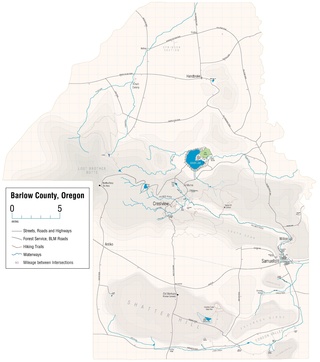Barlow County: Difference between revisions
| Line 22: | Line 22: | ||
<blockquote>''“We have a Walmart but no Target. A McDonald’s, but no Burger King—yet somehow two Taco Bells. Timber, ranching, and farming form the backbone of the local economy, but anymore the real money is in tourism—hikers and campers, hunters and fishermen, skiers, and—with the recent growth of Dryer Lake Resort—golfers.”''<br /> | <blockquote>''“We have a Walmart but no Target. A McDonald’s, but no Burger King—yet somehow two Taco Bells. Timber, ranching, and farming form the backbone of the local economy, but anymore the real money is in tourism—hikers and campers, hunters and fishermen, skiers, and—with the recent growth of Dryer Lake Resort—golfers.”''<br /> | ||
—Melisende Dulac<ref>''[[Crossroad]]''</ref></blockquote> | —Melisende Dulac<ref>''[[Crossroad]]''</ref></blockquote> | ||
{| class="wikitable" | |||
|- | |||
| '''County Seat''' || [[Samuelton]] | |||
|- | |||
| '''Largest City''' || [[Samuelton]] | |||
|- | |||
| '''Area''' || 798 sq mi (1,284 km<sup>2</sup>) | |||
|- | |||
| '''Population''' (2019 est): <br /> Density: || 15,921<br /> 19.9/sq mi (12.4/km<sup>2</sup>) | |||
|} | |||
==Appearances== | ==Appearances== | ||
Revision as of 16:27, 23 April 2019
Barlow County is the primary setting of the Melisende Dulac Series.

Details
“Half the county is under the Columbia River Flood Basalts, a three thousand foot thick veneer good for builders stone and gravel, and not much else. But here and there, especially in the south, things are a bit more interesting. Ancient river beds warped and metamorphosed by uplift, mountains built up and torn down. Volcanic episodes fifteen million years ago may be what brought up the metals they found here in the 1890s.”
—Darby Wormwood[1]
Barlow is a fictional county in the high desert region of central Oregon, with Samuelton as its largest town and seat of government. Much of the county is made up of high desert rangeland, ranches, and farms. The west central portion of the county is dominated by Lost Brother Butte, the dormant volcano home to the Brother Drop Ski Resort. The villages of Crestview and Munro are found on the lower eastern slope of the mountain.
The south county is dominated by Shatter Hill, with Fallback Ridge and Ole Hamilton Hill in its eastern shadow. The best barbecue in the valley can be had at the Nethers Roadhouse in Condon Valley at the eastern end of Shatter Hill.[2]
The north county is primarily desert with irrigated farm and ranch land. A few tiny hamlets, including Handbrake, dot the wide, gently undulating region. Copper Baron Lake, once an open pit mine, lies in the saddle between three hills outside Handbrake.[3]
On the northeast flank of Lost Brother Butte is Dryer Lake, home of the Dryer Lake Resort, a developed community featuring a golf course, high-end shopping village, and luxury homes and cottages.
The Palmer River flows east from Lost Brother Butte through the Palmer River Valley, snaking through Wilton and Samuelton.
Location
Because it is fictional, Barlow doesn't appear on any Oregon map. However, in examining such a map, you might see that Barlow seems to have been carved out of portions of Jefferson and Wasco counties. Barlow's precise geography differs in significant ways from the area claimed while also being typical of that part of Oregon.
Demographics
Barlow County has fewer than fifteen-thousand permanent residents, more than half in Samuelton. The rest are scattered throughout the high desert and foothills rising up to Lost Brother Butte.
“We have a Walmart but no Target. A McDonald’s, but no Burger King—yet somehow two Taco Bells. Timber, ranching, and farming form the backbone of the local economy, but anymore the real money is in tourism—hikers and campers, hunters and fishermen, skiers, and—with the recent growth of Dryer Lake Resort—golfers.”
—Melisende Dulac[4]
| County Seat | Samuelton |
| Largest City | Samuelton |
| Area | 798 sq mi (1,284 km2) |
| Population (2019 est): Density: |
15,921 19.9/sq mi (12.4/km2) |